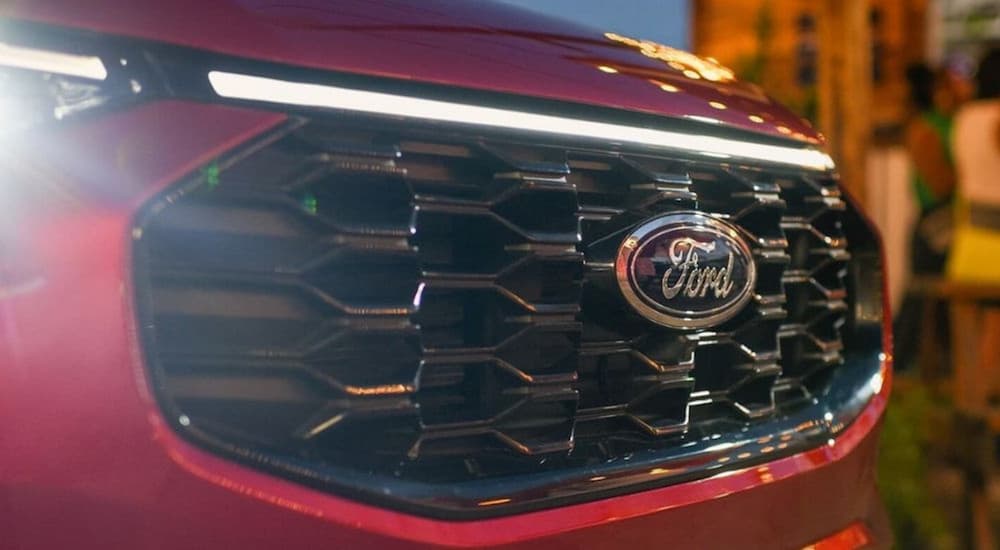In today’s car market, $32,000 doesn’t amount to much. That sort of cash would cover the closing costs, repairs, and moving fees for a new house, a minor heart surgery, or the Princess Diana-themed “Crowning a Lady” package at The Drake luxury hotel in Chicago, but it’s a pretty modest budget when you’re shopping for a new car, truck or SUV. New car prices are nearly at a record high, with buyers paying around $50,000 on average, so while $32K might sound like a healthy sum, ever-rising costs have left drivers with fewer options. It can be a frustrating situation when you set out to source your next vehicle, especially if you’re looking for something a little more exciting than your typical family sedan or crossover. Until you look at a Ford Escape for sale. The crossover has been an exceedingly popular choice since it first hit the market in 2001, with sales topping every Ford model outside of the F-150. That’s a pretty strong showing and one that can be largely credited to the compact’s contemporary design, a generous suite of comfort, convenience, and safety tech, and, perhaps most importantly, its potent powertrain.
While the Escape comes standard with a 1.5L three-cylinder engine, the crossover has featured an available 2.0L EcoBoost engine ever since the third-generation Escape made its debut in 2013. This optional engine offers the sort of performance that’s virtually unheard of in the non-luxury compact SUV market these days, with a 250 hp setup that’s designed to inject a little excitement into the daily driving experience. It certainly seems to follow through; when equipped with the 2.0L engine, the 2025 Escape boasts some of the best horsepower, acceleration, and towing in its class, which are three lofty superlatives for an SUV that costs less than a night spent cosplaying as the Princess of Wales. Let’s learn a little more about the 2.0L EcoBoost engine and see how it managed to power the Escape to the top of the compact crossover segment.
Base and Hybrid Engines Maximize Efficiency…
The Escape can be optioned with four diverse powertrains for 2025. The first, a 1.5L EcoBoost three-cylinder engine, isn’t going to win you any drag races with its 180 hp, but it does offer ample efficiency with an EPA-estimated 27 MPG in the city and 33 MPG on the highway. The 1.5L mill comes standard on the Active and ST-Line trims, and while it might be the logical option for drivers who value fuel economy above all else, it’s hard to make a case for the base engine in a world where the 2.0L version exists. Ford also offers the Escape in Hybrid and Plug-In Hybrid formats for 2025, and though the electrically-assisted SUVs do provide between up to 40 MPG combined, they both lag behind the gas-powered version with a maximum output of 210 hp.

…But the 2.0L Option Has Got It Where It Counts
If the options listed above seem a little underwhelming, it might be time to step up to the 2.0L EcoBoost engine. Available on the Escape’s ST-Line Select, ST-Line Elite, and Platinum trims, the 2.0L engine delivers 250 hp and 280 lb-ft of torque and includes all-wheel drive as a standard feature. These stats make the Ford Escape one of the few compacts under $35,000 to offer anything in the neighborhood of 250 hp, and once you throw in a smooth, eight-speed automatic transmission, investing in the 2.0L engine is a bit of a no-brainer, especially if you’re the type of driver who appreciates the sort of dynamic driving experience that the extra horsepower can provide. The upgraded engine pairs well with the Escape’s compact design, allowing the nimble crossover to accelerate with ease and providing some satisfying results when you start to open up the throttle. An included Sport Mode allows drivers to really test the SUV’s limits by stiffening the steering and adjusting the transmission to prioritize the lower gears.
Speed In Spades
Citing the Escape’s striking performance stats is all well and good, but these sorts of figures can often lack context. In order to see how the SUV’s engine performs in real-world scenarios, the classic zero to 60 mph test comes in pretty handy. The 2.0L turbocharged engine allows the Escape to scoot up to speed in as little as 5.7 seconds—an impressive figure that puts the Escape right towards the top of the compact segment when you exclude luxury models. It’s also a major improvement over the base three-cylinder engine, which takes 7.7 seconds to reach the same speed even when equipped with AWD.
The four-cylinder engine’s performance is all the more noteworthy when you start to dig into the numbers. The Escape posted a strong showing in a 2024 Car and Driver comparison that pitted the Ford against similar compact offerings from Dodge, Honda, Kia, Mazda, Nissan, Toyota and Volkswagen, and though it wasn’t the most powerful model on offer, a clever bit of engineering allowed the SUV to etch its name all across the score sheet with the quickest zero-to-30-mph, zero-to-100-mph, 30-to-50-mph and 50-to-70-mph times out of the bunch. Throw in a blistering 1/4 mile time of 14.4 seconds at 97 mph, and it’s easy to see how the Escape has made such a name for itself in the compact segment.
Compact But Capable
The Ford Escape’s stellar performance might grab all the attention, and for good reason, but the 2.0L engine also opens the door to a level of utility rarely seen in the segment. Drivers who value towing capacity don’t normally gravitate towards the compact class, but the Escape isn’t your average compact. The SUV’s four-cylinder engine can churn out 280 lb-ft of torque in addition to its 250 hp, which opens the door to some surprising feats of towing strength. When equipped with the 2.0L EcoBoost engine and AWD, the Escape can pull up to 3,500 lbs, which is some 75 percent more than the three-cylinder model with its 199 lb-ft of torque. The 2.0L design is even more remarkable when compared to the Escape’s Hybrid and PHEV iterations, which offer less than half as much towing capacity at 1,500 lbs. Once again, the Escape tops the charts, tying the Mazda CX-50 to lead the segment and leaving lesser rivals like the Kia Sportage (2,500 lbs), Ford Bronco Sport (2,200 lbs) and Toyota RAV4 (1,500 lbs) in the dust.
New Tech Enhances Efficiency
If the Escape’s noteworthy performance resume came at the cost of efficiency, it would probably still be one of the more compelling options in the compact segment, but that’s simply not the case. When paired with the 2.0L EcoBoost engine, the Escape achieves an EPA-estimated 23 MPG in the city, 31 MPG on the highway, and 26 MPG combined. This sort of showing is made possible in part by Ford’s Auto Start-Stop technology, which cuts fuel consumption and emissions by deactivating the engine whenever the Escape comes to a prolonged stop. The base turbocharged three-cylinder engine is the clear winner in terms of efficiency, but the 2.0L manages to keep pace while lapping the base engine in terms of performance.
Accessible Performance
When equipped with the 2.0L EcoBoost engine, the Ford Escape might just be the sleeper hit of the compact crossover segment. The SUV leads the segment in some critical categories and is outfitted with all the tech, safety, and comfort features that it takes to compete in today’s cutthroat crossover market. The Active and ST-Line trims might lack the larger EcoBoost engine, but are still an exceptional value when you factor in their sub-$30,000 price tag. The ST-Line Select adds some important comfort features like remote start, heated mirrors, heated seats, and a heated steering wheel, while the ST-Line Elite ups the ante in terms of tech and advanced driver-assistance systems like Adaptive Cruise Control, Evasive Steering Assist, Intersection Assist, and Rear Parking Sensors. The Platinum edges into luxury territory with ActiveX upholstery and other premium touches while still managing to keep the price right around $35,000. No matter which trim you choose, the 2.0L EcoBoost engine is well worth the investment, opening the door to a level of performance rarely seen outside of the luxury segment while remaining accessible to the average driver.




